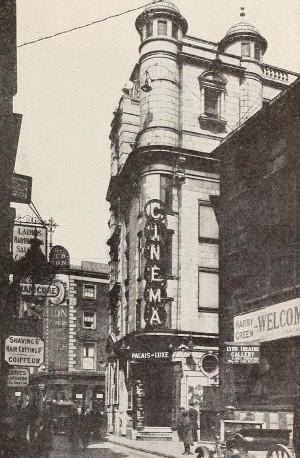The Palais de Luxe at 17-19 Great Windmill Street opened in December 1910, on the edge of Soho near Piccadilly Circus. The building was originally designed as a carriage-builder’s showroom, with workshops on the floors above, although it had been extensively remodelled in an effort to attract well-to-do West End audiences.1 However, by the end of the 1920s, according to Elsie Cohen, the cinema had fallen into disrepute, and it was sold to new owners, who intended to turn it into a live theatre. While the plans for conversion were going ahead, Cohen (who had previously worked as a journalist and a film sales agent) persuaded the new management to let her run the venue temporarily as a specialist repertory theatre.2
Although Cohen gives a slightly earlier date, her management of the Palais de Luxe seems to have started in May 1930, shortly after the earlier repertory cinema the Avenue Pavilion on nearby Shaftesbury Avenue closed for conversion to sound. During the summer of that year, the Palais showed a series of popular ‘art’ films and Hollywood revivals, including the German films The Last Laugh and Metropolis, early two-reel comedies by Charlie Chaplin, and the World War I epic Wings.3 In September it showed the Soviet film Turksib, a documentary about the building of the Turkestan-Siberian railway, which was shown in a double bill with the Buster Keaton comedy Steamboat Bill Jr.4 This juxtaposition of films was characteristic of Cohen’s programming at the Palais. It also resembled the deliberately eclectic screenings of the Film Society, which (from 1925) organised seasons of Sunday shows for its members at various West End cinemas.5
During Cohen’s short tenure, the cinema was known as one of the last bastions of silent films in a West End marketplace otherwise dominated by ‘talkies’. It closed and reopened in June 1931 as the Windmill Theatre, which would become famous for its ‘Revudeville’ cabaret shows.6 By this point, Cohen had taken over programming at the Academy Cinema on Oxford Street, where she introduced a similar repertory policy.
Image: The Palais de Luxe, ca.1923, from ‘Seeing Movies in London’, Picture-Play Magazine, November 1923, p. 27. Credit: Library of Congress Packard Campus for Audio Visual Conservation and the Media History Digital Library: www.mediahistoryproject.org.
Further reading:
- Allen Eyles with Keith Skone, London’s West End Cinemas, third edition (Swindon: English Heritage, 2014).
- Paul Rotha, ‘The “Unusual” Film Movement’, Documentary News Letter, June 1940, p. 13.
- Anthony Slide, interview with Elsie Cohen, The Silent Picture, Summer-Autumn 1971, unpaginated (pp. 16-20).
- ‘Metropolitan Notes’, Kinematograph and Lantern Weekly, 4 October 1917, p. 106. ↩
- Anthony Slide, interview with Elsie Cohen, The Silent Picture, Summer-Autumn 1971, unpaginated (pp. 16-20); Allen Eyles, ‘Cohen, Elsie (d. 1972)’, Oxford Dictionary of National Biography (Oxford: Oxford University Press, 2004): http://dx.doi.org/10.1093/ref:odnb/56535 (Subscription Only). ↩
- ‘The Film World’, The Times, 3 September 1930, p. 10. ↩
- ‘Theatres’, Sunday Express, 21 September 1930, p. 12. ↩
- Jen Samson, ‘The Film Society, 1925-1939’, in Charles Barr (ed.), All Our Yesterdays: 90 Years of British Cinema (London: British Film Institute, 1986), pp. 306-13. ↩
- Allen Eyles with Keith Skone, London’s West End Cinemas, third edition (Swindon: English Heritage, 2014), p. 28. ↩



